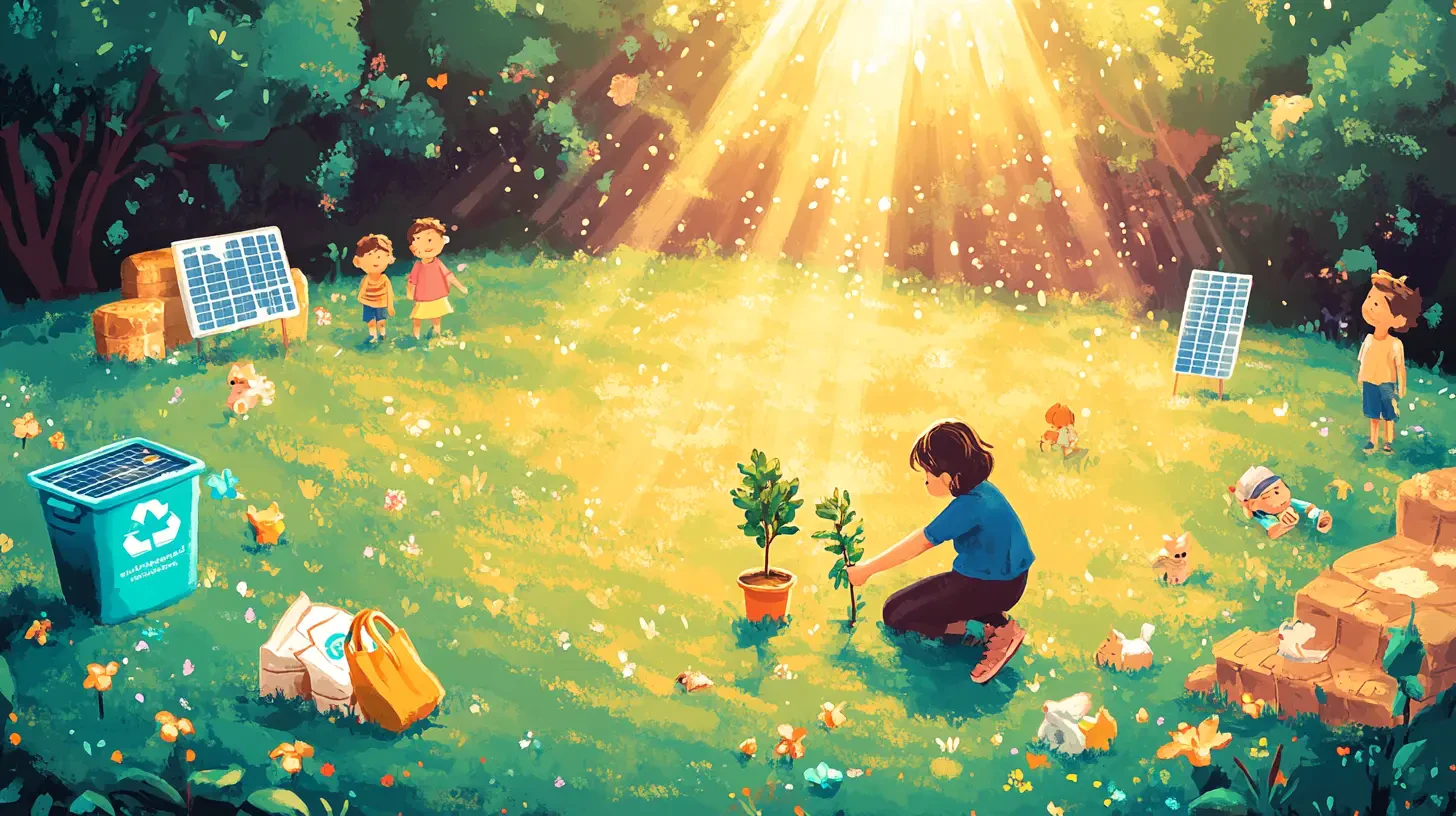Get to Know Climate Change: A Global Crisis That Should Not Be Ignored

Amid increasingly erratic and severe weather conditions each year, climate change is no longer merely an environmental issue—it has become a global crisis that directly affects daily life, health, the economy, and the security of humanity as a whole.
Understanding the root causes of the problem, its far-reaching impacts, and the ways in which everyone can contribute to addressing it is a crucial first step—one that can no longer be delayed.
The Meaning of the Term "Climate Change"
Climate Change refers to a phenomenon of growing significance that has received increasing attention in recent times due to its direct and indirect impacts on the Earth and humanity. This article discusses the meaning and evolution of the concept of climate change.
Definition of Climate Change
Climate Change refers to long-term changes in weather patterns in a specific area, which may persist for decades or longer. Various organizations define the term differently, as follows:
- According to the United Nations Framework Convention on Climate Change (UNFCCC): Climate Change refers to changes in climate that are directly or indirectly caused by human activities and that alter the composition of the global atmosphere. These changes are in addition to natural climate variability observed over comparable time periods.
- According to the Intergovernmental Panel on Climate Change (IPCC): Climate Change refers to any change in climate that may be attributed to natural variability or to human activity.
- According to the National Aeronautics and Space Administration (NASA): Climate Change is defined as long-term changes in average weather patterns, which play a role in determining the climate characteristics of the Earth at local, regional, and global levels.
These changes in average weather patterns include various climate-related factors such as temperature, humidity, precipitation, seasons, and wind patterns. All of these elements are crucial to the survival of life on Earth.
The Difference Between “Climate Change” and “Global Warming”
The terms “climate change” and “global warming” are often used interchangeably. While they are closely related, they carry distinct meanings in academic and scientific contexts.
- Global Warming refers to the increase in the average temperature of the Earth's surface air and oceans, a trend that has become more noticeable since the latter half of the 20th century. This rise in temperature is primarily driven by the continuous accumulation of greenhouse gases in the atmosphere. Global warming is thus considered a component of the broader phenomenon known as climate change.
- Climate Change, on the other hand, is a broader and more comprehensive term. It encompasses long-term changes in weather patterns and climate characteristics, such as shifts in seasons, the frequency and severity of storms, droughts, floods, and the rising sea level. Global warming is one of the major impacts included under this broader umbrella.
Climate change is a complex phenomenon with far-reaching consequences for the environment, the global economy, and human society. Understanding its true meaning and studying its development through diverse sources is essential for planning and policy-making to address the ongoing and increasingly severe changes.
Public awareness and participation at all levels—local, national, and global—are key to fostering cooperation and implementing sustainable solutions to this global challenge.
The Impact of Climate Change on the World and Daily Life
Climate change is no longer a distant issue. It has become a silent threat that is gradually transforming the world in every dimension—environmentally, ecologically, and socially—affecting wildlife, ecosystems, human health, and overall quality of life. Rising temperatures and increasingly severe natural disasters are threatening biodiversity and food security.
At the same time, these effects are imposing growing economic and health burdens, especially on vulnerable populations. The world is now facing a critical turning point that demands urgent and decisive action.
Impact on the Environment, Ecosystems, and Wildlife
Climate change is having a profound effect on ecosystems and biodiversity across the globe. Rising temperatures are decreasing the survival rates of many species due to dwindling food sources, unsuccessful reproduction, and disrupted native habitats.
Many animals and plants are facing changes to their natural habitats. As temperatures climb, plants tend to bloom earlier or migrate to cooler regions. Animals that depend on these plants must also adapt, but some may not be able to adjust in time, increasing their risk of extinction.
More intense natural disasters—such as wildfires, storms, and droughts—are destroying key habitats. Studies show that 57% of recorded species exhibit behaviors indicating negative effects from extreme weather events. Moreover, rising sea levels pose a growing threat to native species in the Arctic and on various islands. It is estimated that up to 19% of over 4,447 islands could be submerged, placing more than 300 endemic species at risk.
Impacts on Human Health, Economy, and Livelihoods
Climate change has a profound impact on human health. It is projected that by 2050, there will be an additional 14.5 million deaths and a total global economic loss of $12.5 trillion. Between 2030 and 2050, the average number of deaths is expected to reach about 250,000 annually due to malnutrition, malaria, diarrhea, and heat-related illnesses.
Rising temperatures and heatwaves increase the risk of diseases such as heatstroke and skin cancer. At the same time, worsening air quality due to elevated ground-level ozone may exacerbate respiratory conditions like asthma. Long-term exposure to unsafe ozone levels also raises the risk of chronic illnesses, such as chronic lung disease.
On the economic front, climate change causes damage to property and infrastructure, impacts public health and workforce productivity, and affects key sectors such as agriculture, forestry, fisheries, and tourism. If global temperatures rise by 4.5°C by 2090, it is estimated that approximately 9,300 people will die from heat-related causes in urban areas of the United States, with associated economic losses of around $140 billion per year.
Higher temperatures also reduce agricultural productivity, limiting farmers' ability to produce food. This directly affects the food supply chain and commodity prices, particularly in food-insecure communities often located in areas prone to drought and extreme temperature fluctuations. It may even lead to competition between humans and animals for basic resources like food and water.
The impacts of climate change are not felt equally by all. Vulnerable groups—such as the elderly, children, low-income families, and marginalized communities—are often hit the hardest. They may live in buildings without adequate cooling systems and lack the resources to prepare for or recover from climate-related disasters such as storms, floods, and other extreme weather events.
The Root Causes and Key Factors Contributing to Climate Change
Climate change is caused by both human activities and natural factors. However, in the present era, human activity is considered the primary force accelerating global warming.
Human Activities Contributing to Climate Change
- Burning of Fossil Fuels: The combustion of fossil fuels such as coal, oil, and natural gas is a major source of carbon dioxide (CO₂), the leading greenhouse gas responsible for global warming. Since the Industrial Revolution, CO₂ levels in the atmosphere have steadily risen. By 2020, atmospheric CO₂ concentration was 48% higher than pre-industrial levels. Industries reliant on fossil fuels—power generation, transportation, and manufacturing—continue to emit greenhouse gases, fueling a self-reinforcing cycle of climate change. Additionally, burning fossil fuels releases other pollutants such as particulate matter, sulfur dioxide (SO₂), and nitrogen oxides (NOx), which are harmful to human health and the environment.
- Deforestation: Forests play a critical role in absorbing CO₂ through the photosynthesis process in trees and vegetation. Deforestation reduces this natural carbon sink, leading to an increase in greenhouse gases in the atmosphere. Moreover, when forests are cleared—especially through burning for agriculture or urban expansion—the carbon stored in soil and biomass is released. Recent data indicates that deforestation contributes to approximately 11% of global greenhouse gas emissions, with emissions from tropical regions rising rapidly.
- Other Human Activities
- Livestock Farming: Ruminant animals like cows and sheep emit methane during digestion. Methane has a far higher heat-trapping ability than CO₂.
- Use of Nitrogen-Based Fertilizers: These fertilizers release nitrous oxide, a long-lived greenhouse gas.
- Landfilling of Organic Waste: Organic waste decomposing in anaerobic conditions produces methane, a potent greenhouse gas.
Natural Factors Related to Climate Change
While human activity is the dominant driver today, natural factors have also played a role in long-term climate fluctuations. These include:
- Volcanic Activity: Volcanic eruptions can influence global temperatures by releasing particles that reflect sunlight, leading to short-term cooling, while also emitting CO₂. However, volcanic CO₂ emissions are about 50 times lower than human emissions and are not a primary cause of global warming.
- Changes in Solar Radiation: Although solar output affects Earth’s climate, recent variations in solar radiation are not sufficient to explain current warming. If solar activity were the main driver, the entire atmosphere would be warming, yet observed warming is concentrated in the lower atmosphere.
- Earth’s Orbital Changes: The Earth undergoes natural warm and cold cycles due to shifts in its orbit and axial tilt, known as the Milankovitch cycles. These changes affect the distribution of solar energy on Earth but occur over extremely long timescales and are not responsible for current warming trends.
While natural elements contribute to climate variability, scientific evidence overwhelmingly shows that human activities—especially the burning of fossil fuels and deforestation—are the primary drivers behind the rapid intensification of global warming in the modern era.
Guidelines and Measures for Addressing Climate Change
Tackling climate change requires both individual actions and national-level policies, with the key objective of reducing greenhouse gas emissions by at least 48% by 2030 and achieving net-zero emissions by the early 2050s.
Reducing Greenhouse Gas Emissions and Promoting Clean Energy
At the policy level, the government has implemented various measures to support the reduction of greenhouse gas emissions and promote the use of clean energy, such as:
- Supporting the transition to renewable energy sources, including solar, wind, and biomass
- Setting targets for emission reductions across key economic sectors
- Promoting investment in efficient and environmentally friendly public transportation systems
- Implementing reforestation and ecosystem restoration projects
- Developing green infrastructure in urban areas to mitigate the impacts of climate change
Thailand is currently in a critical phase of shaping its climate policy, including the drafting of key documents such as the Climate Change Act and the National Energy Plan. These documents will provide essential frameworks for the country’s long-term environmental strategy.
The Role of Technology and Innovation
In addition to policy efforts, technology and innovation play a vital role in reducing greenhouse gas emissions. Key developments and promoted technologies include:
- Direct Air Capture technology to remove carbon dioxide directly from the atmosphere
- Long-duration energy storage systems to enhance the stability of the energy grid
- Smart Grid technologies for efficient energy management
- Improving energy efficiency in buildings and appliances to reduce energy waste
Individual Participation
Each person’s actions can have a significant impact on the environment. When these actions are combined, they can lead to widespread change.
Changes in Daily Life
Small behavioral adjustments in daily life can greatly reduce environmental impact. Examples include:- Reducing meat consumption and opting for more plant-based foods
- Using public transportation, walking, or cycling instead of driving personal vehicles
- Washing clothes in cold water and air-drying them instead of using a dryer
- Buying second-hand products and cutting down on single-use plastics
- Improving energy efficiency at home, such as using LED light bulbs
Community Engagement and Social Movements
Beyond individual behavior, community-level participation is also crucial. This can be done through various activities such as:
- Attending local meetings or events related to climate change
- Supporting organizations or groups working on environmental and climate issues
- Advocating for serious climate policies from the government
- Spreading knowledge and raising public awareness about the issue
Addressing climate change requires cooperation across all sectors—individual actions, government policies, and international collaboration—all working toward the shared goal of reducing greenhouse gas emissions and building a sustainable future.
International Cooperation and Future Directions in Climate Change
International cooperation on climate change has significantly evolved since the establishment of the United Nations Framework Convention on Climate Change (UNFCCC), particularly following the adoption of the Kyoto Protocol in 1997 and the Paris Agreement in 2015.
Cooperation Through International Agreements and Organizations
The Paris Agreement marked a pivotal moment in global climate cooperation. Its goal is to limit the rise in global average temperature to well below 2°C, while striving to keep it below 1.5°C above pre-industrial levels. Unlike the Kyoto Protocol, the Paris Agreement does not impose legally binding greenhouse gas reduction targets. Instead, it emphasizes a process in which each country sets its own targets and regularly reports on its progress.
The Climate Promise 2025 initiative, a system-wide effort by the United Nations, aims to support countries in implementing their Nationally Determined Contributions (NDCs) in alignment with the 1.5°C target. The initiative focuses on improving policy quality, enhancing investment capacity, and accelerating actions that promote sustainable development.
Trends and Future Challenges
The world faces escalating climate challenges in several key areas:
- Rising Global Temperatures: The year 2024 has been recorded as the hottest in history, with average global temperatures 1.60°C above pre-industrial levels. Projections suggest that 2025 will be among the three hottest years, with expected temperature increases ranging from 1.29°C to 1.53°C.
- Extreme Weather Events: Extreme weather continues to occur with increasing frequency and severity, exacerbated by the ongoing use of fossil fuels.
- Economic Challenges: Climate change poses severe economic risks, particularly for major coastal cities such as Rio de Janeiro, Shanghai, Miami, and Osaka, which are vulnerable to flooding caused by rising sea levels.
- Clean Energy Competition: The transition to clean energy has become a focal point of global strategic competition, especially among the United States, the European Union, and China, all of which are investing in the development and trade of green technologies.
- Renewable Energy: Renewable energy remains the driving force behind global energy expansion. By 2025, it is expected to account for more than 90% of new electricity generation capacity.
International cooperation continues to play a crucial role in addressing the climate crisis. However, political and geopolitical uncertainties may pose obstacles to collaborative efforts. Sustaining climate policy continuity amid political transitions will be vital to ensuring long-term progress at both governmental and private-sector levels.
About Optiwise
Optiwise offers Investor Relations & ESG consulting services, corporate website design, and IR website development. We also provide advisory services for initial public offerings (IPOs) and assists in preparing disclosure documents for public companies. Additionally, our public relations efforts aim to build credibility and enhance the corporate image.
For more information about Optiwise's services, please contact us here.


